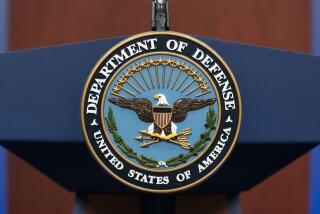Pentagon Braces for the Unpredictable: a Counterstrike
- Share via
WASHINGTON — Though Iraqi forces have been barely visible during the air assault on their country, the Pentagon is bracing for a longshot counterstrike that it fears could still come from Iraq’s unpredictable leader, Saddam Hussein.
As they pounded the country for the second day, U.S. military officials reinforced troops and equipment in the region to guard against a tank attack on Kuwait and put on alert Patriot antimissile batteries to shield against Scud missiles.
They continued to systematically hammer the huge but rickety Iraqi air-defense system, which they worry could still shoot down U.S. pilots, winning propaganda points for the Iraqi regime and causing domestic and international problems for President Clinton.
Hussein’s “million-man army” has been reduced by more than half since the Persian Gulf War in 1991, when some U.S. analysts predicted that the biggest armed force in the Middle East might inflict tens of thousands of casualties on the United States and its allies.
Iraq’s conventional forces have been starved for spare parts, operating funds and training.
Yet they are taken seriously enough that top administration officials believed that it was necessary to warn that any resistance would bring a massive reaction.
“We have indicated to Iraq that it ought not to threaten its neighbors, or it would be met with a very severe consequence from the United States,” Defense Secretary William S. Cohen said Wednesday.
U.S. military planners have worried since the Gulf War about the possibility of a tank attack on Kuwait, which could inflict casualties on Americans and Kuwaitis and would demonstrate that Hussein was not taking the latest air attack without resisting.
During the Persian Gulf War, the Iraqis’ 5th Mechanized Infantry Division sent an armed column south to invade the Saudi city of Khafji. That attack caught the coalition forces off guard.
The column was soon destroyed, but the Iraqis still view the skirmish with pride. Officials believe that they might be tempted to try something similar.
The Iraqis are believed to still have about 2,700 tanks.
U.S. forces keep about 2,500 soldiers, along with tanks, armored vehicles and other equipment, in Kuwait in anticipation of an attack. Cohen is sending an additional 1,500 soldiers to reinforce them.
Daniel Goure, a defense analyst with the Center for Strategic and International Studies, said that, although the odds were not high for a tank attack similar to Iraq’s effort in 1991, “it is probably the most real threat” from the Iraqis.
U.S. and Kuwaiti forces probably are not large enough now “to stop a real concerted thrust,” he said.
It is unclear how much of a Scud missile force the Iraqis now possess. Estimates run from two to about two dozen, and it is unclear whether the missiles are fully assembled or equipped with warheads.
Though the risk is small, one reason for concern is that Iraq still may possess the capability of delivering chemical or biological weapons. The international repercussions from any Scud attack would be huge--especially if it were launched against Israel and drew massive retaliation.
The Iraqi air defense network, the first target of attack in the air assault, has been in general decline since the 1991 war. Modeled on a Soviet system and partially built by the French, the system lacks parts and, in the view of many U.S. analysts, never functioned smoothly.
Through constant surveillance, U.S. forces have learned the location and operations of its hundreds of mobile and fixed surface-to-air missile batteries.
U.S. fliers know, in general, how to get through the system without harm or how to operate outside its reach.
In the first night of attack, U.S. forces sent decoys toward Baghdad, where the air defenses are most concentrated, to draw surface-to-air fire. Once the missiles fire, U.S. forces know their location.
Even so, a senior U.S. military official said he considered the system “robust” and “sophisticated.” And despite international sanctions, some analysts believe that Hussein has been able to upgrade the system in the past two years with imported parts.
There is the risk, moreover, that the missiles and the antiaircraft fire may simply get lucky and hit the U.S. planes with what pilots call “the golden BB.”
Hussein is clearly willing to fire his surface-to-air missiles at U.S. aircraft. But would he risk more?
Fighting back is, in many ways, the most foolish approach he can take because it would give the United States the excuse for a massive response against his remaining forces, analysts said. Logically, he should lie low and try to simply win points for surviving a U.S. attack.
“Inaction in the face of U.S. action has its own power,” analyst Goure said.
Yet “could he want to just make a show?” one official asked. “We just can’t be sure.”
More to Read
Sign up for Essential California
The most important California stories and recommendations in your inbox every morning.
You may occasionally receive promotional content from the Los Angeles Times.














